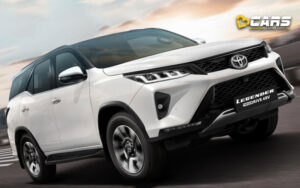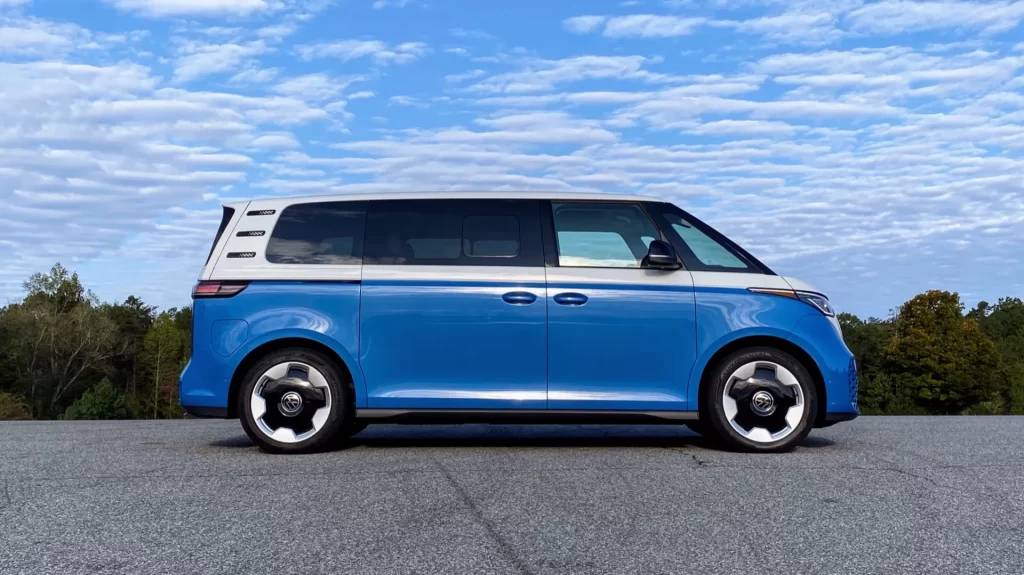
Here’s something the data doesn’t tell you: minivans have never been better.
Minivans are nowhere near as popular as they were at the end of the 20th century. Sales have plummeted from 1.3 million in 2000, to 306,000 last year. But the four that stream out of showrooms today—the Honda Odyssey, Toyota Sienna, Kia Sedona, and Chrysler Pacifica—have been great family providers, with mostly middling fuel economy.
That’s about to change. After years of delays, the new 2025 Volkswagen ID.Buzz electric van will revitalize the minivan with battery power. It’s not doing it by itself: today, three other minivans sport hybrid or plug-in hybrid options, leaving the Honda Odyssey by itself in the gas-only era. But it’s the only battery-only model, with no other one on the horizon. It cashes in on the retromod trend of resurrecting bygone nameplates, but those sliding side doors make it a standout.
They’re all strong performers in their segment, but which of these minivans are the best to own? The stalwarts or the newfangled, the combustions or the electrifieds?
Our rankings factor in cost of ownership as well as sticker price, so they favor hybrids. Yet safety and interior roominess play important roles, as does how easily small hands can move big seats to make their own way in the world. Connectivity and easy to use features also rate high.
From power-sliding side doors to all-wheel drive with a charge, these family haulers are making all the right moves. Here’s how they rank (all prices include destination).
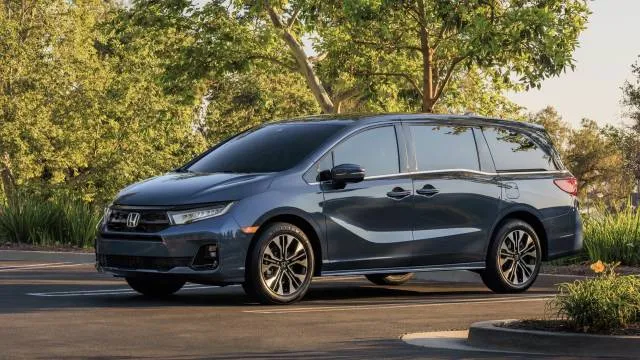
2025 Honda Odyssey

2025 Honda Odyssey
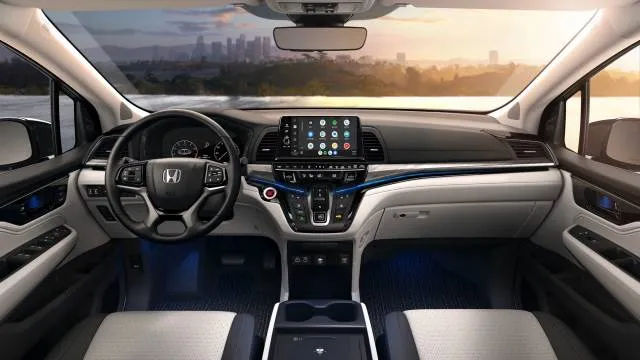
2025 Honda Odyssey
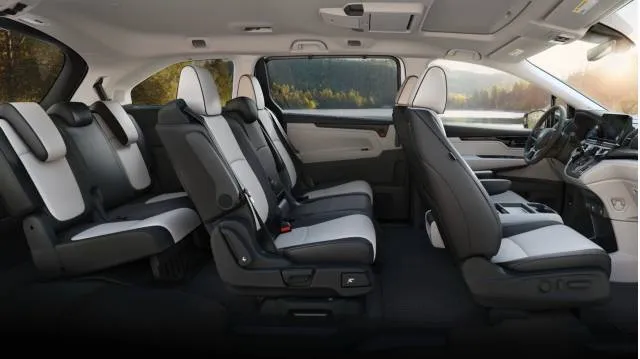
2025 Honda Odyssey
- Price and trim range: EX-L ($43,315), Sport-L ($44,465), Touring ($48,005), Elite ($52,275)
- Powertrain: 280-hp 3.5-liter V-6 with a 10-speed automatic and front-wheel drive only
- MPG: 19 mpg city, 28 highway, 22 combined
- Standout features: Heated power front seats, sunroof, wireless smartphone charger standard
Honda has pared down the Odyssey lineup in recent years, but the fifth-generation Odyssey last redesigned in 2018 has grown stale. It’s the only minivan to lack a hybrid powertrain option, and it only comes in front-wheel drive. On the upside, it’s one of the better handling minivans with good steering and exceptional reliability—one of the benefits of not really changing much over the years. The downside is that the infotainment and tech overall lags behind rivals, fueling speculation that Honda will either discontinue the Odyssey after a 30-year run or update it with a hybrid powertrain in the next year or two. Honda’s belated push to electrification includes not just making the CR-V Hybrid and Accord Hybrid the top sellers for those models, but also planning an electric three-row crossover due in 2027. We’ll see if the Odyssey’s journey continues, Homer.

2025 Chrysler Pacifica

2025 Chrysler Pacifica

2025 Chrysler Pacifica

2023 Chrysler Pacifica
- Price and trim range: Voyager ($41,690), Select ($44,145), Limited ($51,760), Pinnacle ($56,425)
- PHEV price and trim range: PHEV Select ($52,750), PHEV S ($58,995), PHEV Pinnacle ($61,975)
- Powertrain: 287-hp 3.6-liter V-6 with a 9-speed automatic; AWD adds $2,995
- Plug-in hybrid (PHEV) powertrain: 260-hp 3.6-liter V-6 with two electric motors and a 12.5-kwh (usable) battery pack with a CVT
- MPG: 19/28/22 mpg; 17/25/20 mpg with all-wheel drive
- PHEV MPG: 32 miles of electric range; the equivalent of 82 mpg with gas and electric power; 30 mpg combined without electric
- Standout features: Stow ‘N Go seats that fold into the floor (not on PHEV); available AWD (not on PHEV); luxurious options
When the plug-in hybrid Pacifica launched in 2018, a year after Chrysler replaced the Town & Country with the gas-powered Pacifica, the classic Chrysler became a tale of two minivans: The Pacifica still has the revolutionary Stow ‘N Go seats that fold into the floor in both the second and third rows, and it has available all-wheel drive; the Pacifica Hybrid is the only PHEV minivan and it can 32 miles around town without ever needing the gas engine—perfect for family errands—but it can’t be had with second-row Stow ‘N Go seats or all-wheel drive. Chrysler adds a third wrinkle this year by bringing back the Voyager as a budget base model to customers instead of just fleets, but at nearly $42,000, how much of a value is the Voyager? It wears the Pacifica’s old skin but has modern content, including a standard 10.1-inch touchscreen with wireless smartphone compatibility as well as Stow ‘N Go in both rear rows. It lacks the more luxurious options of the Pacifica that tip it toward the $60,000 edge. It’s worth noting that the Pacifica PHEV qualifies for the full $7,500 federal EV tax credit, so depending on your income, it could cost nearly the same as the gas model.

2025 Toyota Sienna

2025 Toyota Sienna

2025 Toyota Sienna

2025 Toyota Sienna
- Price and trim range: LE ($40,635), XLE ($45,445), XSE ($48,090), Limited ($51,650), Woodland ($51,875), Platinum ($57,595); all-wheel drive costs $2,000 extra, though it’s standard on Woodland and only $760 on Platinum
- Powertrain: 245-hp 2.5-liter inline-4 with two motors (all-wheel drive adds a third motor to power the rear axle), a hybrid transmission, and front-wheel drive
- MPG: 36 mpg combined with front-wheel drive; 35 mpg combined with all-wheel drive
- Standout features: At least 35 mpg combined, available AWD
A standard hybrid with either 36 mpg combined with front-wheel drive, or 35 mpg with all-wheel drive, the Sienna continues to check all the practical boxes for minivan owners. The second row seats are bolted down, however, and more difficult to remove than any other minivan in the class, limiting its versatility. With six trims and heaps of options, there’s a Sienna for most tastes. Its 245-hp inline-4 and two-motor hybrid system (three motors with all-wheel drive) lacks the grunt of the V-6 options in the class, but Toyota tunes its suspension to be less wobbly than rivals and it’s a stable highway cruiser. Like the Pacifica, it gets expensive at the top, and even though it offers up a built-in vacuum and cooler, as well as footrests and other fancy options, it’s more practical than posh in any of its myriad configurations.

2025 Kia Carnival Hybrid

2025 Kia Carnival Hybrid

2025 Kia Carnival Hybrid

2025 Kia Carnival Hybrid
2. Kia Carnival
- Price and trim range: LX ($37,895), LXS ($39,895), EX ($42,095), SX ($46,995), SX Prestige ($51,995)
- Hybrid price and trims: It costs $2,000 more in LXS, EX, SX, and SX Prestige grades
- Powertrain: 287-hp 3.5-liter V-6 with an 8-speed automatic, front-wheel drive only
- Hybrid powertrain: 242 -hp 1.6-liter turbo-4 with a single motor, 6-speed automatic, and front-wheel drive only
- MPG: 18/26/21 mpg; 34/31/33 mpg hybrid
- Standout features: Refined hybrid, smart storage space, value, 5-year/60,000-mile warranty
The new hybrid option makes the Carnival much more than a good time; it elevates the ride with efficiency and refinement. The refreshed Carnival may lack features such as all-wheel drive or fold-in-the-floor seats, but it does just about everything else well, especially in the hybrid model. It comes well equipped with an easy infotainment interface, has an exceptional warranty, and is the value play in the class without feeling at all like a budget car.

2025 Volkswagen ID.Buzz

2025 Volkswagen ID.Buzz

2025 Volkswagen ID.Buzz

2025 Volkswagen ID.Buzz
1. Volkswagen ID. Buzz
- Price and trim range: Pro S ($61,545), Pro S Plus ($65,045), 1st Edition ($67,045); adding a second motor for all-wheel drive adds $4,500 to Pro S Plus and 1st Edition models
- Powertrain: 282-hp single motor with rear-wheel drive or 335-hp with dual-motor all-wheel drive; 91-kwh battery pack
- MPG: 234 miles of range with one motor or 231 miles with two motors
- Standout features: New look for a new age, great outward vision, all-electric model, roomy second row
Our TCC Rating might seem to reflect a preference for shiny new things without dirty tailpipe emissions (read more about how we rate cars) but the return of the Volkswagen Bus in electric ID.Buzz form revitalizes the minivan segment while also pointing it forward. In two-tone form with a long wheelbase and snubbed ends, it cashes in on the retro trend but excels at modern power delivery, with a 91-kwh battery pack feeding a one- or two-motor drivetrain. At up to 234 miles, range might seem on the low end for a new EV, but this is the roomiest and heaviest minivan on sale. Instant torque lends it decent launch from a stop, and the battery in the floor between the axles makes it feel planted. The cockpit has views without a hood like the original Bus, but it has clever storage options such as a dash shelf for the passenger, a smartphone charging recess, and a clean look. The downside are climate controls in the 12.9-inch touchscreen and temperature sliders that can be less than precise. Since it’s made in Germany, it doesn’t qualify for a tax credit, so it’s relatively expensive compared to other minivans. But such is the cost of shiny—and comparatively clean—new things



